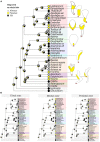A flat petal as ancestral state for Ranunculaceae
- PMID: 36212342
- PMCID: PMC9532948
- DOI: 10.3389/fpls.2022.961906
A flat petal as ancestral state for Ranunculaceae
Abstract
Ranunculaceae comprise ca. 2,500 species (ca. 55 genera) that display a broad range of floral diversity, particularly at the level of the perianth. Petals, when present, are often referred to as "elaborate" because they have a complex morphology. In addition, the petals usually produce and store nectar, which gives them a crucial functional role in the interaction with pollinators. Its morphological diversity and species richness make this family a particularly suitable model group for studying the evolution of complex morphologies. Our aims are (1) to reconstruct the ancestral form of the petal and evolutionary stages at the scale of Ranunculaceae, (2) to test the hypothesis that there are morphogenetic regions on the petal that are common to all species and that interspecific morphological diversity may be due to differences in the relative proportions of these regions during development. We scored and analyzed traits (descriptors) that characterize in detail the complexity of mature petal morphology in 32 genera. Furthermore, we described petal development using high resolution X-Ray computed tomography (HRX-CT) in six species with contrasting petal forms (Ficaria verna, Helleborus orientalis, Staphisagria picta, Aconitum napellus, Nigella damascena, Aquilegia vulgaris). Ancestral state reconstruction was performed using a robust and dated phylogeny of the family, allowing us to produce new hypotheses for petal evolution in Ranunculaceae. Our results suggest a flat ancestral petal with a short claw for the entire family and for the ancestors of all tribes except Adonideae. The elaborate petals that are present in different lineages have evolved independently, and similar morphologies are the result of convergent evolution.
Keywords: Ranunculaceae; ancestral state reconstruction; elaborate petals; floral morphology; petal development.
Copyright © 2022 Delpeuch, Jabbour, Damerval, Schönenberger, Pamperl, Rome and Nadot.
Conflict of interest statement
The authors declare that the research was conducted in the absence of any commercial or financial relationships that could be construed as a potential conflict of interest.
Figures





References
-
- Akaike H. (1974). A new look at the statistical model identification. IEEE Trans. Autom. Control 19 716–723. 10.1109/TAC.1974.1100705 - DOI
-
- APG (1998). An ordinal classification for the families of flow-ering plants. Ann. Mo. Bot. Gard. 85, 531–553.
-
- Ballerini E. S., Min Y., Edwards M. B., Kramer E. M., Hodges S. A. (2020). POPOVICH, encoding a C2H2 zinc-finger transcription factor, plays a central role in the development of a key innovation, floral nectar spurs, in Aquilegia. Proc. Natl. Acad. Sci. U. S. A. 117 22552–22560. 10.1073/pnas.2006912117 - DOI - PMC - PubMed
-
- Benson L. (1940). The North American Subdivisions of Ranunculus. Am. J. Bot. 27 799–807. 10.2307/2436909 - DOI
LinkOut - more resources
Full Text Sources

